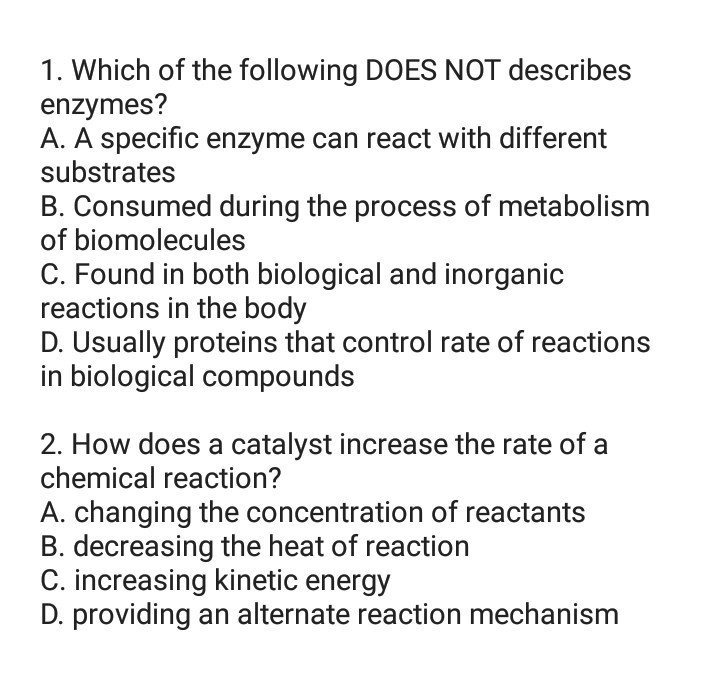1. Which of the following DOES NOT describes enzymes? A. A specific enzyme can react with different substrates B. Consumed during the process of metabolism of biomolecules C. Found in both biological and inorganic reactions in the body D. Usually proteins that control rate of reactions in biological compounds 2. How does a catalyst increase the rate of a chemical reaction? A. changing the concentration of reactants B. decreasing the heat of reaction C. increasing kinetic energy D. providing an alternate reaction mechanism
1. Which of the following DOES NOT describes enzymes? A. A specific enzyme can react with different substrates B. Consumed during the process of metabolism of biomolecules C. Found in both biological and inorganic reactions in the body D. Usually proteins that control rate of reactions in biological compounds 2. How does a catalyst increase the rate of a chemical reaction? A. changing the concentration of reactants B. decreasing the heat of reaction C. increasing kinetic energy D. providing an alternate reaction mechanism
Chemistry for Today: General, Organic, and Biochemistry
9th Edition
ISBN:9781305960060
Author:Spencer L. Seager, Michael R. Slabaugh, Maren S. Hansen
Publisher:Spencer L. Seager, Michael R. Slabaugh, Maren S. Hansen
Chapter8: Reaction Rates And Equilibrium
Section: Chapter Questions
Problem 8.20E: In each of the following, which reaction mechanism assumption is apparently being violated? Explain...
Related questions
Question

Transcribed Image Text:1. Which of the following DOES NOT describes
enzymes?
A. A specific enzyme can react with different
substrates
B. Consumed during the process of metabolism
of biomolecules
C. Found in both biological and inorganic
reactions in the body
D. Usually proteins that control rate of reactions
in biological compounds
2. How does a catalyst increase the rate of a
chemical reaction?
A. changing the concentration of reactants
B. decreasing the heat of reaction
C. increasing kinetic energy
D. providing an alternate reaction mechanism
Expert Solution
This question has been solved!
Explore an expertly crafted, step-by-step solution for a thorough understanding of key concepts.
This is a popular solution!
Trending now
This is a popular solution!
Step by step
Solved in 2 steps

Knowledge Booster
Learn more about
Need a deep-dive on the concept behind this application? Look no further. Learn more about this topic, chemistry and related others by exploring similar questions and additional content below.Recommended textbooks for you

Chemistry for Today: General, Organic, and Bioche…
Chemistry
ISBN:
9781305960060
Author:
Spencer L. Seager, Michael R. Slabaugh, Maren S. Hansen
Publisher:
Cengage Learning


Introductory Chemistry: An Active Learning Approa…
Chemistry
ISBN:
9781305079250
Author:
Mark S. Cracolice, Ed Peters
Publisher:
Cengage Learning

Chemistry for Today: General, Organic, and Bioche…
Chemistry
ISBN:
9781305960060
Author:
Spencer L. Seager, Michael R. Slabaugh, Maren S. Hansen
Publisher:
Cengage Learning


Introductory Chemistry: An Active Learning Approa…
Chemistry
ISBN:
9781305079250
Author:
Mark S. Cracolice, Ed Peters
Publisher:
Cengage Learning

Physical Chemistry
Chemistry
ISBN:
9781133958437
Author:
Ball, David W. (david Warren), BAER, Tomas
Publisher:
Wadsworth Cengage Learning,

World of Chemistry, 3rd edition
Chemistry
ISBN:
9781133109655
Author:
Steven S. Zumdahl, Susan L. Zumdahl, Donald J. DeCoste
Publisher:
Brooks / Cole / Cengage Learning

Chemistry: Matter and Change
Chemistry
ISBN:
9780078746376
Author:
Dinah Zike, Laurel Dingrando, Nicholas Hainen, Cheryl Wistrom
Publisher:
Glencoe/McGraw-Hill School Pub Co